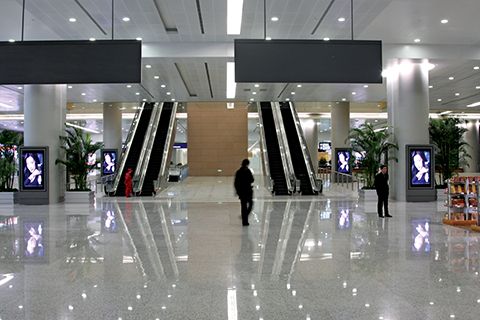By Lou Carulli
In the days before digital signage, smartphones, social media and dedicated apps, travelling often involved a hectic, chaotic mix of paper schedules, maps and a lot of guesswork. Streamlining the process and eliminating as much confusion as possible for business travellers, vacationers, daily commuters and other travellers has long been a major priority for the transportation industry around the world.
Today, with the integration of digital signage and other technologies, there are many cases where travellers—both local and long-distance—are reaping numerous benefits.
Airports
Most travel hubs, but especially airports, are known for being confusing and stressful facilities to navigate. Digital signage has been implemented throughout many airport terminals around the world in an effort to reduce these negative factors and help provide an orderly, structured visual system that allows travellers to get important information with a minimal amount of effort.
The majority of these digital signage displays are designed to integrate seamlessly into the existing structures of the terminals, providing easy access to information at key navigational points along a traveller’s path in a fast, modern and efficient fashion. This integration is accomplished in a variety of ways, from large overhead screens for ease of visibility to smaller information kiosks that serve as user-friendly interactive stations. Useful content displayed on these digital signs includes not only flight arrival and departure times and gate numbers, but also weather reports and special alerts.
In addition to assisting travellers with wayfinding information and orienting them to the layout of a large terminal, digital signage has been shown to decrease their perceived wait times in lines, allowing them to relax. Even when shopping and dining at the airport, they will feel less stress knowing they can check the nearest screen for all the information they need.
Zurich Airport in Switzerland is one of Europe’s important international gateways and has often been considered one of the finest airports in the world. When the time came to implement digital signage, the airport’s in-house team decided to create their own network. They used content distribution and management software to send information to more than 100 screens installed throughout the airport terminal’s departure and arrival zones, as well as 34 synchronized screens in the baggage claim area.
In addition to providing travel information for passengers in a hurry, Zurich Airport’s digital signs feature co-ordinated advertising, along with entertainment and ‘atmospheric’ content to enhance the environment for travellers.

Shanghai’s Pudong and Hongqiao International Airports use digital signage software that broadcasts from a single computer, so only one content manager is needed to monitor a network of more than 200 displays.
The main network has provided a foundation for further communications. In the airport’s Upperdeck restaurant, for example, 28 flat-screen displays in horizontal (landscape) mode have been installed in one seamless row. They provide real-time flight information and entertainment for travellers who do not want to have to leave the comfort of the restaurant to visit a kiosk, but still want to keep track of their travel schedule. And in keeping with the restaurant’s travel theme, the screens also give customers a bird’s eye view of a variety of global destinations with atmospheric content.
In Mumbai, India, meanwhile, Chhatrapati Shivaji International Airport also uses digital signage to meet travellers’ cultural needs. In addition to the usual content mix of travel information, news headlines, weather reports and live TV broadcasts, the airport showcases astrology forecasts for its many Hindu travellers.
Further, passengers aren’t the only ones benefiting from the adoption of digital signage in airports. The medium is vastly beneficial to administrative staff, too, as it can centralize and simplify ‘omni-channel’ information, including facility-wide public service and security alerts, and thus reduce operating costs while increasing safety. The goal of an omni-channel approach is to connect many different types of device outputs to a single management platform, built into the facility’s existing information technology (IT) framework. This way, all display devices can be managed from a single point.






